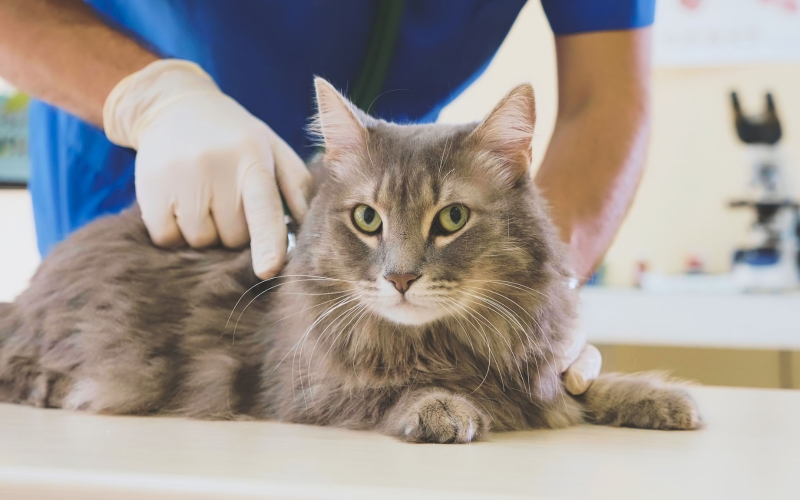Hyperthyroidism in Cats

What is Hyperthyroidism?
Hyperthyroidism is a condition that occurs when the thyroid gland, located in the neck, makes too much thyroid hormone. Usually this is due to a benign (not cancerous) overgrowth of thyroid tissue. Thyroid hormone controls many bodily functions, so too much of this hormone can cause health problems. Hyperthyroidism is most commonly seen in older cats. It is rare in young cats and in dogs of any age.
What are the signs my cat could have hyperthyroidism?
Common things you might notice at home include:
- Increased activity levels or hyperactivity
- Weight loss with a normal or even increased appetite
- Increased thirst and urination
- Occasional vomiting or diarrhea
- Messy or poor haircoat/fur
On examination, your veterinarian might notice muscle loss, high blood pressure, or heart-related symptoms like a heart murmur or fast heart rate. Sometimes the thyroid gland gets large enough that your veterinarian can feel it on exam. Laboratory tests may show mild increases in liver enzymes, and dilute (watered down) urine. If hyperthyroidism is suspected, it is important that your veterinarian performs additional testing, including blood pressure measurement, chest x-rays, kidney function and thyroid hormone testing.
How is hyperthyroidism diagnosed?
There is a simple blood test to measure the amount of thyroid hormone in your cat’s body. In rare cases, more information is needed to make the diagnosis. Your veterinarian might recommend additional testing or they may refer you to a veterinary internal medicine specialist for follow up blood tests or specialized imaging called thyroid scintigraphy.
What are the treatment options for hyperthyroidism?
There are multiple treatment options for hyperthyroidism in cats, including a daily medication called methimazole, a curative injection (radioactive iodine), prescription food and surgery.
Methimazole: This medication can be given by mouth as a pill, or as a gel applied to your cat’s skin. These medications stop the body from making too much thyroid hormone, and must be given every day (usually twice daily) for the life of your cat. Methimazole is a common treatment option because it is low-cost and easily available. Ongoing checkups and blood tests are needed to make sure the treatment is working and to monitor kidney values and for side effects.
Radioactive iodine therapy (i131): i131 is an injection. Ninety-five percent of the time cats are permanently cured with single injection. Because the injection is radioactive, it can only be performed at certain specialty or university veterinary hospitals. Your cat must stay at the hospital for a few days (possibly up to a week or more) until the radiation levels are low enough to be around you again. Sometimes cats need more than one injection, but this is uncommon. Rarely, thyroid hormone levels can become too low (permanent hypothyroidism) but this can be treated with daily medication. The cost of this treatment is higher up front but over time (typically within a year), it becomes cheaper than the other options.
Prescription iodine-restricted diet (Hill’s y/d): This cat food is available by prescription from your veterinarian. Your cat can ONLY eat this diet for the rest of its life and cannot be fed treats or other food. It can be difficult to manage in homes with more than one cat, or when your cat goes outside. For certain cats it can be a good option.
Surgery: The thyroid glands can be removed with surgery, typically by a veterinarian who specializes in surgery. Surgery can be successful but it is expensive, invasive and not without risk. It also requires specialized testing (thyroid scintigraphy), as well as general anesthesia. The other treatment options are just as successful as surgery, are less invasive, carry much less risk, and cost less money. For these reasons, surgery is not a common treatment.
What is the prognosis for a cat with hyperthyroidism?
Hyperthyroidism is a condition that is easy to treat, so most cats have a good prognosis and return to a normal life once diagnosed and treated. For cats treated with medication or dietary therapy, regular life-long monitoring is required. For cats treated with i131, only a few checkups are needed after treatment. Outside of wellness visits, most cats only need ongoing monitoring for about 6 months after treatment.
Articles by Specialty
- Cardiology (19)
- Large Animal Internal Medicine (23)
- Neurology (17)
- Oncology (21)
- Small Animal Internal Medicine (29)
Articles by Animal
- Cats (35)
- Dogs (52)
- Farm Animals (5)
- Horses (12)
